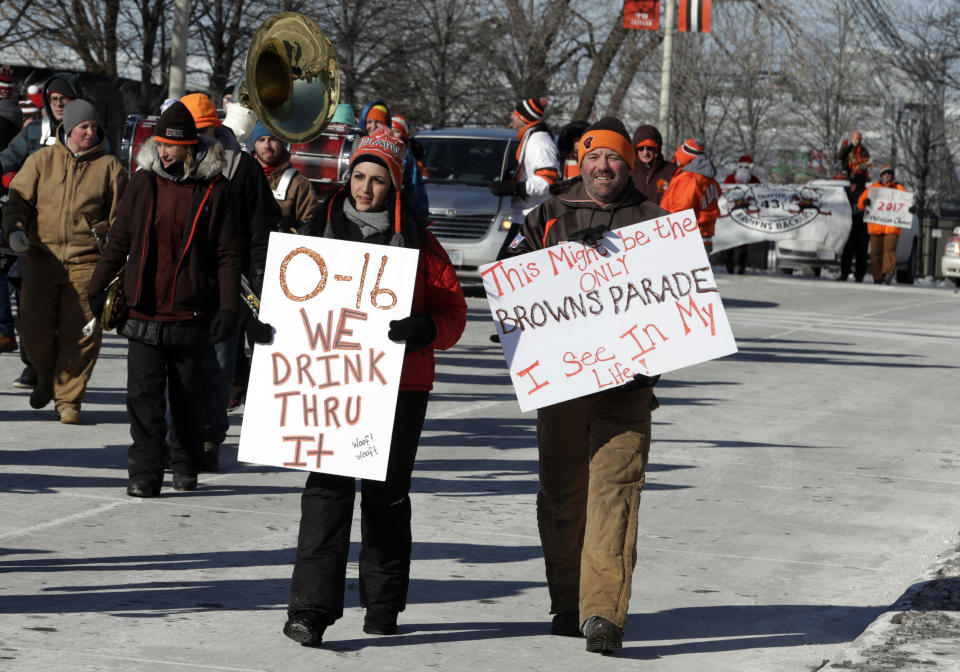Worst moments in Cleveland Browns history

What are the worst moments for each NFL franchise? Yahoo Sports provides our opinion, which you are free to disagree with (and we’re sure you will).
Browns Best Moments | All 32 Teams Best Moments | All 32 Teams Worst Moments

5. Bottlegate
You can’t write the history of unruly NFL fan behavior without a prominent section devoted to Bottlegate, the nickname for the end of the Cleveland Browns-Jacksonville Jaguars game on Dec. 16, 2001. With the Browns trailing and needing a win to stay in playoff contention, wide receiver Quincy Morgan caught a pass for a first down on a critical 4th-and-1, and Tim Couch then spiked the ball intentionally. Despite another play having been run, referee Terry McAulay went back and reviewed the Morgan catch, determining the ball had hit the ground and awarding possession to the Jaguars. Head coach Butch Davis and the Browns were incensed, but as Gus Johnson explained on the broadcast, there was a “malfunction with the communication system between the replay officials in the booth and the officials on the field,” and therefore the review was allowed to stand. The fans vented their frustration by pelting the field with beer bottles and other objects, which forced McAulay and his crew to declare the game over and run for cover despite 48 seconds still on the clock. It’s one of the ugliest instances of fan behavior in North American sports history, and surely a low point for the Browns franchise.
4. The Drive
The Browns were all but headed to Pasadena for Super Bowl XXI. The Denver Broncos were all but done. With 5:43 remaining in the AFC Championship game in 1987, Cleveland had just scored to go up 20-13, and Ken Bell’s misplay of the ensuing kickoff left Denver buried at its own 2-yard line. But John Elway wasn’t trapped in that situation with the Browns; the Browns were trapped in that situation with John Elway. Denver’s Hall-of-Fame quarterback maestro’d a 98-yard march in a little over five minutes, completing 6-of-9 passes for 78 yards in one of the most clutch sequences in NFL history. Cleveland gave up big plays at the worst times, including an 11-yard Elway scamper on a 2nd-and-7 and a 20-yard pass to Mark Jackson on a 3rd-and-18. Jackson caught the game-tying touchdown on third down as well, with Elway’s eyes famously widening as he saw the receiver slide open in the end zone. Even though there was still overtime to be played, Elway’s dart had popped the balloon at Municipal Stadium, and he guided Denver into position for the winning field goal shortly into overtime. As bitter as the moment was, the Browns expected to be back in the AFC title game for years to come. They were, but it only got worse.
3. 0-16 in 2017
The 2017 season was a slow burn, and not the instantaneous heartbreak of other bad moments. That said, it’s the nadir of the Browns franchise since the return, and good God is that a dismal distinction to earn. Combined with the 1-15 season before, it punctuated the worst two-year record for any team in the Super Bowl era, and the misery began right from the start. Three days before the season opener, 2017 No. 1 overall pick Myles Garrett suffered a high ankle sprain and only played 10 games. Rookie quarterback DeShone Kizer, meanwhile, looked like he wasn’t ready to start (which is the kindest way to put it), throwing a league-high 22 interceptions, including an all-time howler against Green Bay in perhaps the most winnable game of the season. And there weren’t many of those; only six games were decided by less than a touchdown. There aren’t many glaring statistics to explain the misfortune, but a few stand out in big fat orange font. The Browns led the league with 41 turnovers and forced a league-low 13, and allowed league highs in opponents’ completion percentage and quarterback rating. The defense also gave up 410 points, second only to the Texans, whose defense was wiped out by injuries. So the Browns couldn’t score, and couldn’t stop anyone from scoring. Sounds like the perfect recipe for the most bizarro parade you’ll see. Only problem is Detroit was the first team to finish 0-16. That’s so Browns. They’re so bad they couldn’t even win this.
2. The Fumble
The Browns returned to the AFC title game a year after “The Drive,” and they were looking to return the favor to the Broncos. Despite falling behind big early, Cleveland rallied in the second half and drove to the Denver 8-yard line with 1:12 remaining. Needing a touchdown to tie the game, Bernie Kosar handed off on a draw to Earnest Byner, who bounced outside then quickly bounced back inside and made a bee-line for the end zone. In a last-ditch attempt to stop him, Broncos defensive back Jeremiah Castille flung his left hand into Byner’s path … and managed to dislodge the ball. Castille recovered it himself (on Denver’s infamous own 2-yard line, no less) and for the second time in two years, Cleveland’s season ended in soul-crushing fashion against the Broncos. In the aftermath, Browns coach Marty Schottenheimer actually heaped more of the blame on wide receiver Webster Slaughter, who was supposed to block Castille downfield but instead just stood around at the goal line. It was one of the few wrong feet put forward by Byner during his five seasons in Cleveland, and fans remember him fondly despite the high-profile mistake. But it happened nonetheless, and it was arguably the first time fans truly wondered if the team and the city it played in were cursed.
1. The move
It seemed unfathomable. Art Modell was going to move the Browns? From Cleveland? That’s exactly what Modell announced he was going to do on Nov. 6, 1995. So was Modell the villain? Did he actually have a legitimate beef with the city? The answer, as it usually does, lies somewhere in the middle. Modell had spent two decades absorbing the costs of operating Municipal Stadium, home of the Browns and Cleveland Indians, and sharing his profits with the city. But he never felt the city responded adequately to his requests for stadium renovations, and when the Indians were granted money for a new stadium, it only exacerbated the bitter feelings. It became clear Modell’s mind was already made up about moving the Browns to Baltimore, and the reaction was fierce. Fans voted to fund stadium renovations, TV analysts spoke out against the decision, even owner Dan Rooney and the bitter rival Pittsburgh Steelers openly protested the move. Regardless, Cleveland was left without its beloved sport for three years. Losing on the field was one thing. Losing the right to play was a complete gut-punch. It only twists the knife further to know that the Baltimore Ravens have won the Super Bowl twice since the move, while the new Browns are posterchildren for dysfunction and struggle. After the final game of the 1995 season, many Browns players ventured near the stands to express appreciation for the fans. Some of those fans took bleachers and other items from the stadium before they left. It was all they could do as a piece of them was being taken away.


